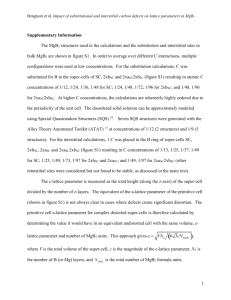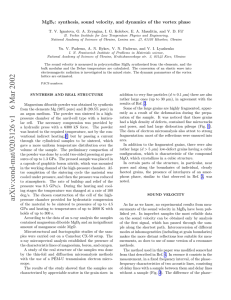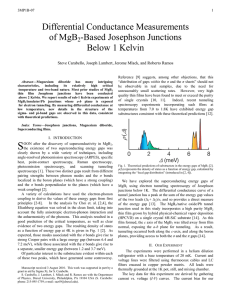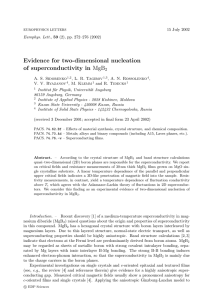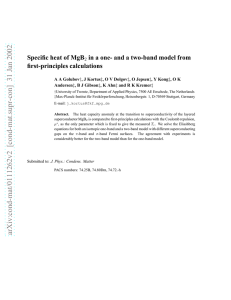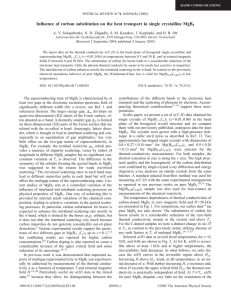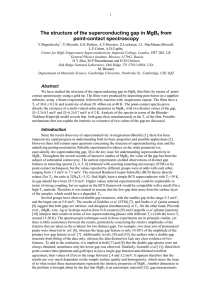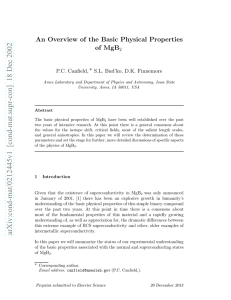Document 11611953
advertisement
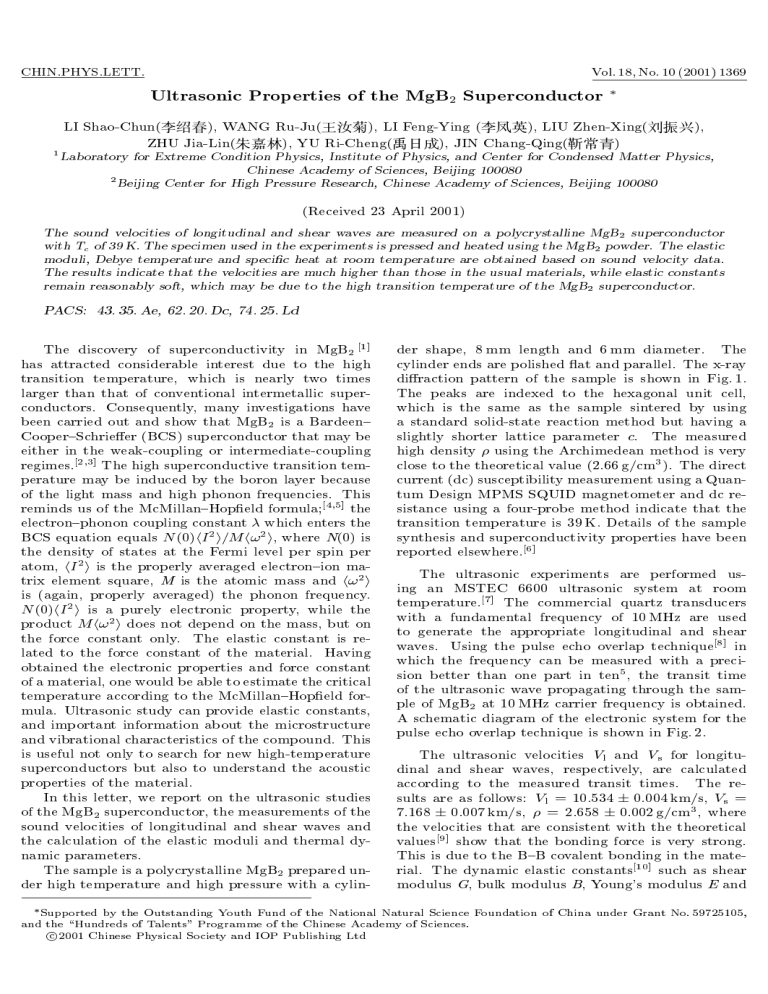
CHIN.PHYS.LETT.
1
Vol. 18, No. 10 (2001) 1369
Ultrasonic Properties of the MgB2 Superconductor LI Shao-Chun( ), WANG Ru-Ju(Æ ), LI Feng-Ying (), LIU Zhen-Xing( ),
ZHU Jia-Lin(), YU Ri-Cheng( ), JIN Chang-Qing( )
Laboratory for Extreme Condition Physics, Institute of Physics, and Center for Condensed Matter Physics,
Chinese Academy of Sciences, Beijing 100080
2
Beijing Center for High Pressure Research, Chinese Academy of Sciences, Beijing 100080
(Received 23 April 2001)
The sound velocities of longitudinal and shear waves are measured on a polycrystalline MgB2 superconductor
with Tc of 39 K. The specimen used in the experiments is pressed and heated using the MgB2 powder. The elastic
moduli, Debye temperature and speci c heat at room temperature are obtained based on sound velocity data.
The results indicate that the velocities are much higher than those in the usual materials, while elastic constants
remain reasonably soft, which may be due to the high transition temperature of the MgB2 superconductor.
PACS:
43. 35. Ae, 62. 20. Dc, 74. 25. Ld
The discovery of superconductivity in MgB2 [1]
has attracted considerable interest due to the high
transition temperature, which is nearly two times
larger than that of conventional intermetallic superconductors. Consequently, many investigations have
been carried out and show that MgB2 is a Bardeen{
Cooper{Schrie er (BCS) superconductor that may be
either in the weak-coupling or intermediate-coupling
regimes.[2;3] The high superconductive transition temperature may be induced by the boron layer because
of the light mass and high phonon frequencies. This
reminds us of the McMillan{Hop eld formula;[4;5] the
electron{phonon coupling constant which enters the
BCS equation equals N (0)hI 2 i=M h!2 i, where N(0) is
the density of states at the Fermi level per spin per
atom, hI 2i is the properly averaged electron{ion matrix element square, M is the atomic mass and h!2i
is (again, properly averaged) the phonon frequency.
N (0)hI 2i is a purely electronic property, while the
product M h!2 i does not depend on the mass, but on
the force constant only. The elastic constant is related to the force constant of the material. Having
obtained the electronic properties and force constant
of a material, one would be able to estimate the critical
temperature according to the McMillan{Hop eld formula. Ultrasonic study can provide elastic constants,
and important information about the microstructure
and vibrational characteristics of the compound. This
is useful not only to search for new high-temperature
superconductors but also to understand the acoustic
properties of the material.
In this letter, we report on the ultrasonic studies
of the MgB2 superconductor, the measurements of the
sound velocities of longitudinal and shear waves and
the calculation of the elastic moduli and thermal dynamic parameters.
The sample is a polycrystalline MgB2 prepared under high temperature and high pressure with a cylin-
der shape, 8 mm length and 6 mm diameter. The
cylinder ends are polished at and parallel. The x-ray
di raction pattern of the sample is shown in Fig. 1.
The peaks are indexed to the hexagonal unit cell,
which is the same as the sample sintered by using
a standard solid-state reaction method but having a
slightly shorter lattice parameter c. The measured
high density using the Archimedean method is very
close to the theoretical value (2.66 g/cm3 ). The direct
current (dc) susceptibility measurement using a Quantum Design MPMS SQUID magnetometer and dc resistance using a four-probe method indicate that the
transition temperature is 39 K. Details of the sample
synthesis and superconductivity properties have been
reported elsewhere.[6]
The ultrasonic experiments are performed using an MSTEC 6600 ultrasonic system at room
temperature.[7] The commercial quartz transducers
with a fundamental frequency of 10 MHz are used
to generate the appropriate longitudinal and shear
waves. Using the pulse echo overlap technique[8] in
which the frequency can be measured with a precision better than one part in ten5 , the transit time
of the ultrasonic wave propagating through the sample of MgB2 at 10 MHz carrier frequency is obtained.
A schematic diagram of the electronic system for the
pulse echo overlap technique is shown in Fig. 2.
The ultrasonic velocities Vl and Vs for longitudinal and shear waves, respectively, are calculated
according to the measured transit times. The results are as follows: Vl = 10:534 0:004 km/s, Vs =
7:168 0:007 km/s, = 2:658 0:002 g/cm3 , where
the velocities that are consistent with the theoretical
values[9] show that the bonding force is very strong.
This is due to the B{B covalent bonding in the material. The dynamic elastic constants[10] such as shear
modulus G, bulk modulus B, Young's modulus E and
Supported by the Outstanding Youth Fund of the National Natural Science Foundation of China under Grant No. 59725105,
and the \Hundreds of Talents" Programme of the Chinese Academy of Sciences.
c 2001 Chinese Physical Society and IOP Publishing Ltd
LI Shao-Chun et al.
1370
Poisson's ratio are also derived from the following
formulae:
X-ray di raction pattern of the high-pressure sintered MgB2 superconductor.
Fig. 1.
Vol. 18
1=3 N
1 + 2 1=3 ;
D = kh 49V
V3 V3
B
T 3 Z Dl =T e xs x4 dx
~!
Cv = 9NkB 2; x = k T :
x
D
B
(e 1)
0
The Debye temperature D obtained is 1096 K
which is close to the theoretical results presented by
Ravindran et al.[9] (Table 2). The speci c heat Cv at
room temperature is 13.5 Jmol 1 K 1 . The results
show that the Debye temperature is very high. This
means that the atoms vibrate at high frequency, which
may contribute to the high-temperature superconductivity.
Table 2. Debye temperature D of MgB2 through ultrasonic
study and the results from other experiments and theoretical
calculations.
Ref. [2] Ref. [15] Ref. [16] Ref. [17] Ref. [9]
D (K) 1096 75030 746
800
920
1016
Acknowledgment: We thank Mr Zhang Bao-hui of
the Institute of Physics, Chinese Academy of Sciences
for his support.
References
[1] Akimitsu J 2001
Symp. on Transition Metal Oxides
(Sendai, 10 January 2001) (presentation)
Schematic diagram of the electronic system for
the pulse echo overlap technique.
Fig. 2.
G = sVs2 ; B = Vl2 34 Vs2 ;
2 2
B
s R2
2
E = 93V
R2 + 1 ; R2 = V 2 ;
s
2
2
= 33RR32 + 11 ; R32 = VB 2 ;
3
l
The calculated results are: G = 136:6 GPa, B =
113:9 GPa, E = 292:8 GPa, = 0:07. The bulk modulus B is consistent with other experiments and theoretical results but slightly smaller (see Table 1), which
is probably caused by the di erent synthesized methods of the sample. From the calculated results, it is
clear that the elastic moduli are soft. This is due to
the light density of the material.
Table 1. Bulk modulus B of MgB2 through ultrasonic study and
the results from other experiments and theoretical calculations.
B(GPa)
113.9
Ref. [13]
1205
Ref. [14]
139
Ref. [9]
150
The Debye temperature D and speci c heat Cv
are also derived[11;12] from the acoustic velocities and
density
[2] Bud'ko S L, Lapertot G, Petrovic C, Cunningham C E,
Anderson N and Can eld P C 2001 Phys. Rev. Lett. 86
1877
[3] Lorenz B, Meng R L and Chu C W 2001 Preprint condmat/0102264
[4] McMillan W L 1968 Phys. Rev. 107 331
[5] Kortus J, Mazin I I, Belashchenko K D, Antropov V P
and Boyer L L 2001 Preprint condmat/0101446
[6] Li S C, Zhu J L, Yu R C, Li F Y, Liu Z X and Jin C Q
2001 Chin. Phys. 10 338
Ren Z A, Che G C, Zhao Z X, Dong C, Ni Y M, Jia S L
and Wen H H 2001 Chin. Phys. Lett. 18 589
[7] Wang J F, Yuan M S et al 1985 Physics 14 372 (in Chinese)
[8] Papadakis E P 1967 J. Acoust. Soc. Am. 42 1045
[9] Ravindran P, Vajeeston P, Vidya R, Kjekshus A and Fjellvag H 2001 Preprint cond-mat/0104253
[10] Edward S D, Anderson O L and Soga N 1973 Elastic Constants and Their Measurement (New York: McGraw-Hill)
[11] Aler A 1961Physical Acoustics: Principles and Methods
III Part B 14 (New York: Academic)
[12] Bradley R S 1963 High Pressure Physics and Chemistry
vol 1 (London: Academic)
[13] Prassides K, Iwasa Y, Ito T, Chi D H, Uehara K,
Nishibori E, Takata M, Sakata S, Ohishi Y, Shimomura
O, Muranaka T and Akimitsus J 2001 Preprint condmat/0102507
[14] Vogt T, Schneider G, Hriljac J A, Yang G and Abell J S
2001 Preprint cond-mat/0102480
[15] Walti Ch, Felder E, Degen C, Wigger G, Monnier R, Delley B and Ott H R 2001 Preprint cond-mat/0102522
[16] Kremer R K, Gibson B J, Ahn K 2001 Preprint condmat/0102432
[17] Bouquet F, Fisher RA, Phillips N E, Hinks DG and Jorgensen JD 2001 Preprint cond-mat/0104206
